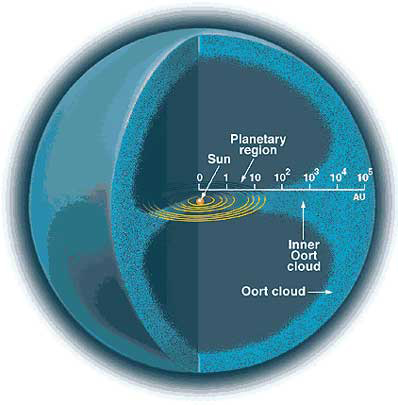FAQ: Will NASA Settle Debate Over Existence of Giant Planet 'Tyche'?

In 1999, a team of astronomers proposed that a gigantic planet — perhaps four times the mass of Jupiter — could be lurking unseen in the Oort cloud, a repository for icy bodies at the edge of the solar system.
The researchers said the presence of this hypothetical planet could explain the unusual orbital paths taken by some comets from the Oort cloud. The planet, which they named Tyche, could have escaped detection to this point by being so far away — perhaps 30,000 times farther from the sun than Earth is — and so cold.
Many other astronomers were not convinced, and the debate over Tyche's existence has continued.
In 2010, the research group that came up with the Tyche idea suggested that evidence for the planet's existence may already have been gathered by a NASA spacecraft — the Wide-field Infrared Survey Explorer (WISE). [Gallery: Photos From WISE]
WISE, which launched in December 2009 and went into hibernation earlier this month, scanned the entire sky in infrared wavelengths during its operational life. WISE may well have picked up signs of Tyche during these scans, the planet's proponents argue — scientists just haven't had enough time to pore over the data yet.
So will WISE observations vindicate the Tyche hypothesis? If so, when? Here's a NASA-provided look at the great Tyche debate and WISE's potential role in resolving it.
When could data from WISE confirm or rule out the existence of the hypothesized planet Tyche?
Breaking space news, the latest updates on rocket launches, skywatching events and more!
It is too early to know whether WISE data confirms or rules out a large object in the Oort cloud. Analysis over the next couple of years will be needed to determine if WISE has actually detected such a world or not.
The first 14 weeks of data, being released in April 2011, are unlikely to be sufficient. The full survey, scheduled for release in March 2012, should provide greater insight. Once the WISE data are fully processed, released and analyzed, the Tyche hypothesis will be tested.
Is it a certainty that WISE would have observed such a planet if it exists?
It is likely but not a foregone conclusion that WISE could confirm whether or not Tyche exists. Since WISE surveyed the whole sky once, then covered the entire sky again in two of its infrared bands six months later, WISE would see a change in the apparent position of a large planet body in the Oort cloud over the six-month period.
The two bands used in the second sky coverage were designed to identify very small, cold stars (or brown dwarfs) — which are much like planets larger than Jupiter, as Tyche is hypothesized to be.
If Tyche does exist, why would it have taken so long to find another planet in our solar system?
Tyche would be too cold and faint for a visible-light telescope to identify. Sensitive infrared telescopes could pick up the glow from such an object, if they looked in the right direction.
WISE is a sensitive infrared telescope that looks in all directions.
Why is the hypothesized object dubbed Tyche, and why choose a Greek name when the names of other planets derive from Roman mythology?
In the 1980s, a different companion to the sun was hypothesized. That object, named for the Greek goddess Nemesis, was proposed to explain periodic mass extinctions on the Earth. Nemesis would have followed a highly elliptical orbit, perturbing comets in the Oort cloud roughly every 26 million years and sending a shower of comets toward the inner solar system. Some of these comets would have slammed into Earth, causing catastrophic results to life.
Recent scientific analysis no longer supports the idea that extinctions on Earth happen at regular, repeating intervals. Thus the Nemesis hypothesis is no longer needed.
However, it is still possible that the sun could have a distant, unseen companion in a more circular orbit with a period of a few million years — one that would not cause devastating effects to terrestrial life. To distinguish this object from the malevolent Nemesis, astronomers chose the name of Nemesis' benevolent sister in Greek mythology, Tyche.
Follow SPACE.com for the latest in space science and exploration on Twitter @Spacedotcom and on Facebook.

Space.com is the premier source of space exploration, innovation and astronomy news, chronicling (and celebrating) humanity's ongoing expansion across the final frontier. Originally founded in 1999, Space.com is, and always has been, the passion of writers and editors who are space fans and also trained journalists. Our current news team consists of Editor-in-Chief Tariq Malik; Editor Hanneke Weitering, Senior Space Writer Mike Wall; Senior Writer Meghan Bartels; Senior Writer Chelsea Gohd, Senior Writer Tereza Pultarova and Staff Writer Alexander Cox, focusing on e-commerce. Senior Producer Steve Spaleta oversees our space videos, with Diana Whitcroft as our Social Media Editor.
